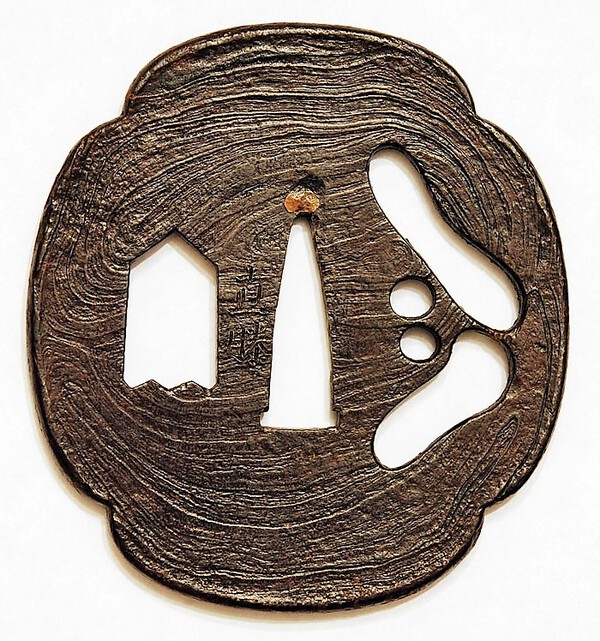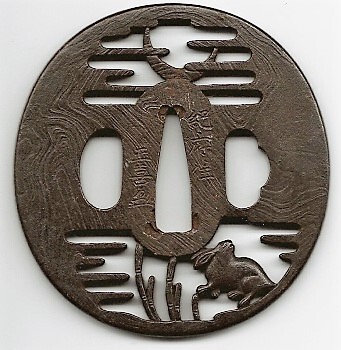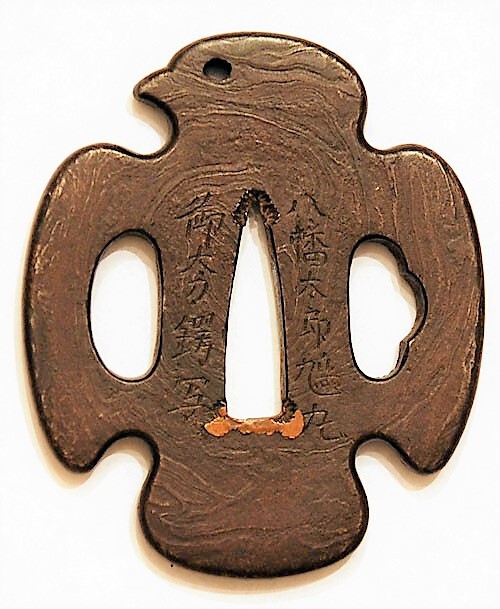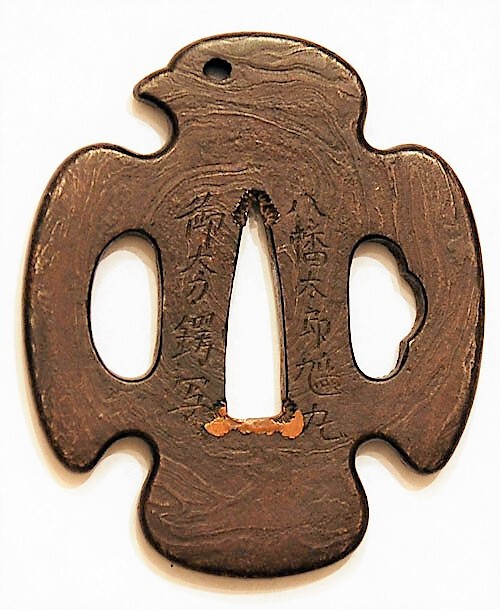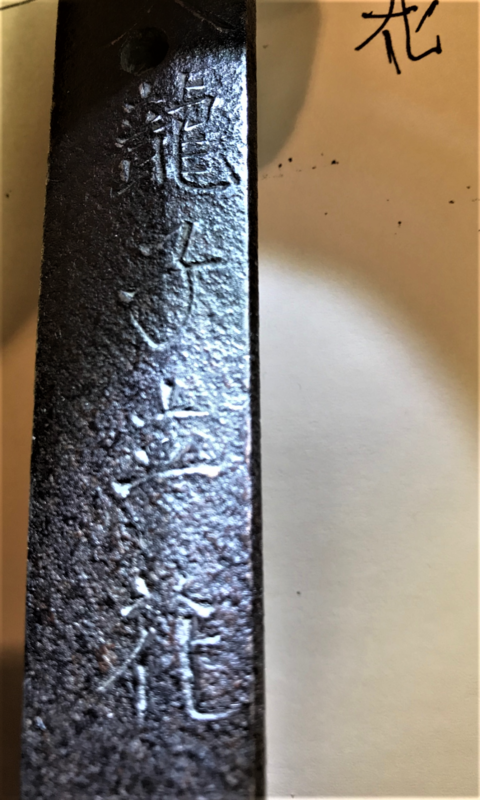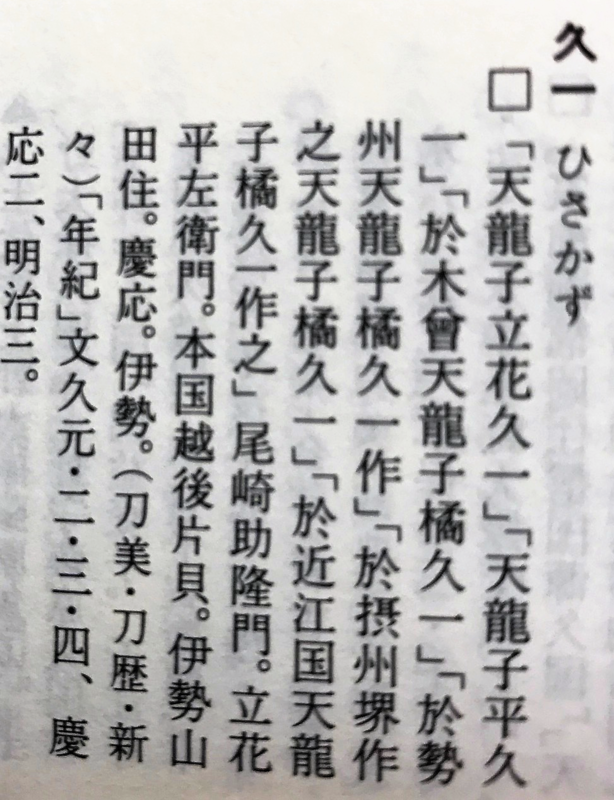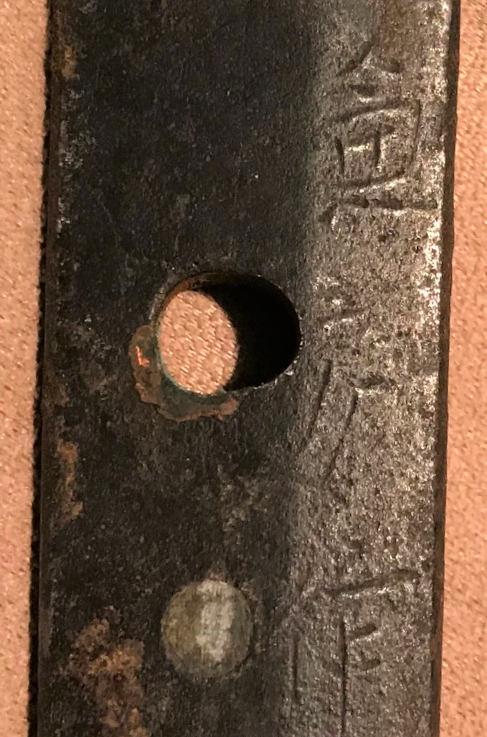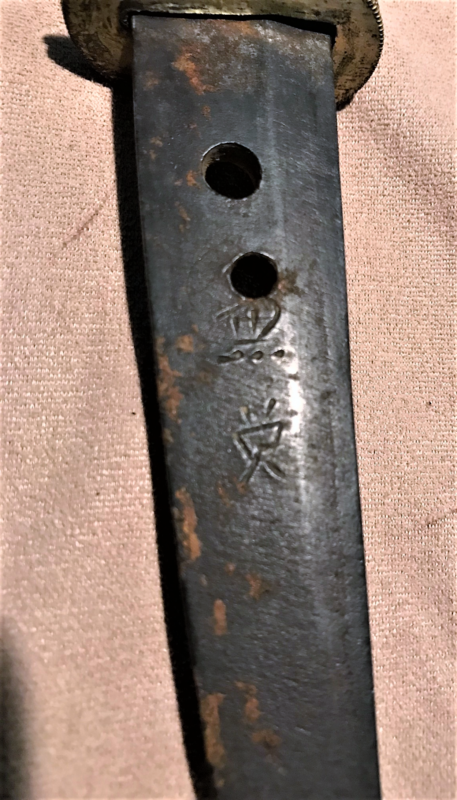-
Posts
703 -
Joined
-
Last visited
-
Days Won
4
Content Type
Profiles
Forums
Events
Store
Downloads
Gallery
Everything posted by Ron STL
-
Question on #3 - is that shakudo plug with the mei on one side of the tsuba, or is plugging a hole throught the tsuba? Ron STL
-
Looking at a couple of Hon'ami evaluations that I haven't looked at for ages, I'd enjoy having them translated kanji by kanji, more complete than I have figured out. The one is a sayagaki by Hon'ami Choshiki of Meiji era. The other is taken from a Hon'ami origami by Hon'ami Ko-on dated 1647. Sayagaki is 5 characters reading: Dai-kin (?) hiaku mai, if I'm reading it correction. I thought this was valued at 30 mai (gold coins) but the third character and it's meaning puzzles me. The origami value is a little different being 6 characters reading: Dai-kin shu (?) (?) mai. This would be helpful to others, too, I would think. Marcus Sesko's book on the Hon'ami family was quite helpful. Will somebody give the translations of these kanji x kanji and explain them please? The sayagaki attributes my daito to Bizen Tomomitsu, later attributed to Omiya den by NBTHK. The origami is for a mumei Juyo katana attributed to Bizen Sanenaga. Ron STL
-
Thanks Christian. I've kept a copy of the photo for my file for my reference in case nothing comes of this. Naomitsu was an interesting guy from what I've read. Was good at placing incorrect signatures on swords, so they say. Ron STL
-
Christian, I am pretty sure that this tsuba -- which I take to be of iron plate -- Naomitsu, student of shinshin-to swordsmith and tsuba maker, Jirotaro Naokatsu. The hitsu-ana are of the Naokatsu group's style and the stroking of the mei looks right-on to an example in my Naokatsu tsuba collection. Certainly nothing fancy, but I'd certainly be interested if it becomes available. I'll attach my example for comparison. I just find it interesting to study the tsuba of Jirotaro naokatsu and his followers along with swords by Jirotaro and his son, Yamon Naokatsu. Ron STL
-
Recently, while looking through the 9-volume set of books, Juyo Bijutsuhen, Collection of Japanese Swords registered as Important Art Objects – 1986, that there seems to be sections of the set that are not identified in English in the index volume. There is an English index for the JuBi swords and koshirae and fittings, but not for other sections. Does anyone have all of these sections of this publication identified in English? It seems there is a lot of information (lists) that are being neglected here because of the lack of understanding Japanese. A couple examples are attached. Thanks. Ron
-
Original marumune is interesting to find on a sword. It should be as it should be, not "rounded off" looking as Ray pointed out on this sword. In the past, I've submitted two swords with maru-mune to shinsa for a friend, and both of those didn't turn out anything very "old" or special, to my (our) disappointment. However, another local sword that ended up in my hands did turn out as hoped for. A mumei naginata-naoshi daito attributed to Naoe Shizu, Nambokucho period. In all these instances the maru-mune was perfectly made and kind of amazing to see. It's tough to be a caretaker of these abused swords we find when we consider to cost (hours of work spent) to restore them (preserve them). I have such a wakizashi here now which I felt was worth preserving. My intention was to sell it for a couple grand and encourage the buyer to polish the sword and do minor repairs on the koshirae. Thinking more about this idea, today, I will sell it at a much lesser price to a newer collector up its chances of being restored. I've also considered having it restored myself and then part with it, but again, how wise is that. Most of us just want to save these swords from destruction since most have already survived centuries of war and use. Ron STL
-

Help/advice With A Potential Purchase
Ron STL replied to nickm's topic in General Nihonto Related Discussion
Looks interesting, for sure. If you get it, be sure to preserve the old sageo with it. If the provenance is true, it is unlikely the nakago has been messed with. Looking forward along with the everyone else to see the bare blade, with or without a mei. Ron STL -

Maybe Munehiro Somebody? Difficult Mei To Read, Help
Ron STL replied to Ron STL's topic in Translation Assistance
Thanks Steve. Myochin did certainly come to mind along with Ki (Ki no...) but I couldn't convince myself. However, I bet you are correct. If so, maybe that's why the feel of the plate attracted me to this simple little tsuba. Peter, you are definitely, this tsuba is very "challenging" to appreciate. It is just something our friend Ted Kiss picked up in Japan a couple months ago. Very likely it was the difficult to read mei that appealed to me. Hate when I can't figure out kanji. Keeps an old man occupied on winter days. Ron STL -
I'm puzzled by the mei on this small but interesting iron tsuba. It was picked up in Japan in October by a local frined. As you can see, the mei is carved close together and hard to read. I might see the name Munehiro saku, but I'm not so sure. The way the mei is carved reminded me of a Hoan Kanenobu tsuba I have, but see nothing that says anything Hoan. Sort of ran into a brick wall with this tsuba. It can use a little TLC as you can see, but I felt the quality of the plate was good. I like the use of shakudo on it, too. Anyone out there able to translate what is on this tsuba? Ron STL Tsuba 1a.pdf Tsuba 1b.pdf
-

Nthk Npo?
Ron STL replied to nagamaki - Franco's topic in Sword Shows, Events, Community News and Legislation Issues
Having had a number of swords through the NBTHK, NTHK and NTHK(NPO) shinsa over the years, doing so can be both exciting and also frustrating. The NBTHK shinsa in my personal opinion, carries the most weight, especially in Japan. The frustrating part is that their origami do not say a lot, so additional homework is required to fully understand their call on a submission. The NTHK shinsa, so I'm told, rejects a high percentage of submission which makes some wonder. Personally, I submitted a sword that had been given personal opinion of Mr. T. as Echizen Rai, but was judged a poorly made Showa sword by NTHK. I've always heard how reliable NTHK(NPO) is, but one judgement called an in-polish blade as some unknown sue-koto smith. It was sent to NBTHK and received a call to Naoe Shizu, Nambokucho (as many of us though, at least age-wise). I think we as collectors must form our own opinion after study, of what a sword appears to be before sending to any shinsa. If results seem hard to accept, seek more study and resubmit it to another shinsa down the road. All of these shinsa judges have seen and studies many, many more swords that we will ever see, but we do study and we should hopefully have gained enough knowledge to accept or to grumble about a shinsa judgement. They are all just an educated opinion, after all. Just some personal sounding off...Ron STL -
I photographed the dozen or so mokume tsuba displayed in Minneapolis, but have been unable to locate that file. Computer incripted a few years ago, lost a lot, but they may be on a disc. Will share them if I find them. Another beautiful, minty tsuba was papered to Jirotaro Naokatsu, but apparently the mei was mis-read by the shinsa team. Nothing looks Naokatsu about it, I realize now. A good opinion of it called it the work of a Myochin smith, whose name escapes me at the moment. What was so interesting seeing a group of these tsuba together, was to take note of the different fineness or boldness found and how different guys interpreted the forging patterns. Also included a "bunny" for you bunny lovers. I'll try and check out the possibility of a display like this at the next Chicago show if table space can be found. Ron STL
-
Looking at my records, I found a little interesting provenance on this tsuba that was kept in its box. Box also has hakogaki by Dr. Torigoye. Box contains label reading “Walther G Kreiner Collection” along with a written notations, “RH 223 Dove tsuba” and “sold to J. Mitchell in 1971 by A. Yates.” (Arthur Yates was a dealer in the early days of collecting fittings.) Robert Haynes said he once owned this tsuba and sold it to Yates in 1971. Ron STL
-
A small but terrific classic tsuba by Myochi Munemasa. Mei reads: (omote) Utsushi (copy) Hachiman Taro Hato-maru (name of a famous tsuba on an Imperial collection tachi); (ura) Ki Munemasa (name of maker). l've seen other examples of this "dove" tsuba but most are of lower quality plate. Also, I've never found a photo of the "Imperial collection tachi" that is supposed to have this tsuba on it. At the first or second Minneapolis show several of us put on a display of mokume plate tsuba which proved to quite interesting. Always wanted to put that display together as an article for the JSS newsletter, but... Ron STL
-
Thanks guys. John, where did this translation come from, Markus by chance? That sure saves a lot of digging and speculation, for sure. As always, greatly appreciate the help. It still puzzles me why (how) the nakago was deteriorated like it is. Reminds me of the very large Jirotaro Naokatsu that Fred Weissberg has...amazing work but no buyers stepping up because of a little rust damage. Shinshinto are expected to be perfectly mint, but often the fine work of the smith gets missed in cases like that, and this blade. Once I gather the data on Hisakazu I'm sure a new owner will be found, eventually. Again, appreciate the feedback. Ron STL
-
Just trying to understand information about this shinshinto katana tonight. The mei reads: Tenryushi Tatsubana Hisakazu saku. I would like to verify that I've translated "Tatsubana" correctly. The only place I found that name was in Nihonto Meikan. Next, also in the Meikan, I'm trying to read what I think is perhaps his birth date and death date, possibly Bunkyu 1st ???, died Meiji 3 (1870). However, the sword id dated Bunkyu August 1863. He certainly didn't make the sword after he died, so where am I going astray here? The katana itself is relatively well make, very little sori and almost straight, in aged shirasaya with sayagaki. Puzzling thing is that the nakago has been damaged by...well, you can see on the photo. Still a nice sword but this of course lowers its value. Enjoying doing some homework on the sword but it will not be kept. Always like to understand as much as possible about anything that comes my way. last time I saw this was in early 1990s. These swords do make the circle from time to time. Ron STL
-
Interesting side story on the gunto mounted Mino Kanefusa. A local friend, primarily a high end uniform collector, advertises regularly land occasionally pulls out sword but other than the military appeal, knows little about the actual "blades." The Kanefusa was one of five he found and asked for help on the lot. He only had interest in the gunto mounted Kanefusa; I ended up with the rest. (No treasures to get too excited about.) A ruminate of a tag intrigued me, so I researched it via Google. Turned out the sword was gifted by a Japanese doctor to a Lt. General who was instrumental in the development of the Atom bomb. Apparently the son, who also achieved Lt. General, sold the sword back in the 1990s to a fellow I once knew (now deceased). Great provenance which made my friend happy. Of course I preached to him to preserve the "blade" since it was sue koto and interesting, but may not get any attention until some future collector has it. Not related to this topic but I thought it was an interesting story to go along with the Kanefusa. Amazing how these century old swords continue to travel. Ron STL
-
Sort of a late follow-up on these mei. I did ask Markus about these and he said the first is Mino, Kanefusa Tenbun era. The other is Kanehide, also Mino and of Tenbun era, 1532-1555. Ron STL
-
Hi Peter. A friend of mine who buys a lot off eBay recently bought this tanto. From pictures, the blade is of WWII era and doesn't look like much to me. However, it does a hamon. On the other hand, the koshirae for it looks very nice quality. Perhaps the nakago is a patriotic saying or something. Being unable to make sense of it, I hoped it could be translated. Nakago looks pretty deterioated as you can see. No worries. Ron STL
-
Thought I posted this yesterday, but apparently not. Just wondering if anyone can make out this mei. Nice koshirae but a puzzling nakago. Anyone? Thanks guys. Ron STL
-
Still unsure of these two mei. As for 1st Kanshiro, I haven't found an oshigata of his me, so until then... The second mei which looks so simple still seems unfound. Tried Markus but no reply yet. I'm sure at this point that both blades are sue-koto and no better. Will let you know if anything real definite comes up. Thanks. Ron STL
-
Yeah, Peter, wish you were closer. We two old timers could have some fun up here! The mei is not tachi-mei which shot down what the sword looked like (very, very optimistically)...ko-Bizen. Yes, I realize that's unlikely but the sugata did remind me of that when I first looked at it. Ray, I did look into Kanefusa, altered by wear, but just can't see that there. I'll dig around tomorrow, the hoso-suguba should give me some direction. Of course KANE always makes one think "Mino." Interesting puzzle. Ron STL
-
Looked a some swords today and found two mei that are puzzling me. The first mei, in a gunto koshirae, is rather interesting. A light weight, narrow katana with very narrow hoso-suguba hamon which appears intact. The mei is small and reads Kane--- (possibly Kanetomo). If Tomo, there is a stroke missing. Interesting old sword, katana-mei, which if mine, would consider polish and shinsa. The other mei is on a wakizashi which shows some interest. Another Kane--- the simple looking second kanji puzzles me, at this point. As to the first sword, "if" Kanetomo, I see one such smith from mid-1300s but the sword is not robust enough (my opinion) to come from that period. Would love to see some thoughts on these two Kane---- smiths if only to confirm the correct reading of both. Help much appreciated. Ron STL
-
Thanks Peter, I never heard of that type of thing. I thought this was two characters, not one, no wonder I was lost. Another interesting piece of WWII history. Ron STL
-








